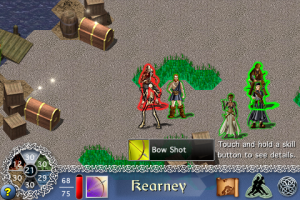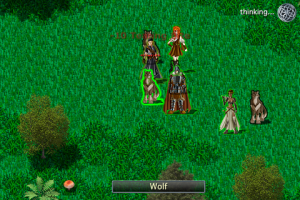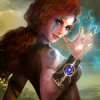Six gods from a Celtic-inspired pantheon have been well-flummoxed for abuse of power in their interactions with mere mortals. However, as luck would have it, the bullies have been left in the playpen as it were; thus it isn’t too long before a pair of medieval brothers awaken to find that all hell has broken loose in their front yard, where skeletons and zombies have arisen to waylay the travels of a mysterious woman named Betha. Unlike everyone else in the countryside she seems to know exactly what’s going on, and begins gathering just folk for a deity-slaying campaign.
Gilli Games has been very careful to label Pantheon Cycle (Out now at a reduced price, $9.99 later) a “Turn-Based Strategy Game” and not a “Strategy RPG.” This distinction is an important signal for gamers to note because the player characters feel just as much like cardboard cutouts as they at first appear (more on that aesthetic decision later). Betha drives the game’s narrative from the shadows while humans that the player should otherwise grow attached to seem content to serve as dutiful, one-dimensional siege monkeys despite the plot’s dramatic potential.
 That Pantheon Cycle‘s plot falls flat isn’t a result of shoddy work on the writing team’s part as much as it is a clear underutilization of their immense talent. Pantheon Cycle sports one of the highest quality scripts I’ve ever seen on the iOS. The story is served up against a narrator’s wonderfully delivered Gaelic-accented voice work, in walls of text that feel noticeably bifurcated from the rest of the game. As it stands the writing quality is great enough that Pantheon Cycle almost works as an effective mashup of the Visual Novel and Turn-Based Strategy genres; it’s just a bit tragic that the characters at the player’s control are given so little attention, tending to randomly spring up from battlefields and participating very little in shaping the direction of the game’s story.
That Pantheon Cycle‘s plot falls flat isn’t a result of shoddy work on the writing team’s part as much as it is a clear underutilization of their immense talent. Pantheon Cycle sports one of the highest quality scripts I’ve ever seen on the iOS. The story is served up against a narrator’s wonderfully delivered Gaelic-accented voice work, in walls of text that feel noticeably bifurcated from the rest of the game. As it stands the writing quality is great enough that Pantheon Cycle almost works as an effective mashup of the Visual Novel and Turn-Based Strategy genres; it’s just a bit tragic that the characters at the player’s control are given so little attention, tending to randomly spring up from battlefields and participating very little in shaping the direction of the game’s story.
Ultimately Gilli Games focused narrowly on developing Pantheon Cycle‘s core gameplay; here, there’s certainly enough depth to satisfy anyone well-steeped enough in the genre to appreciate the subtle nuances in its battle system. As Betha’s growing army travels from one town to the next it’s tasked with defeating a sequential series of supernatural – and, at times, man-made – blights. To this end the player moves her underlings like board game pieces over battlefields made of sprawling hexagonal grids. Each campaign appears limited at first glance but the player reveals tons of additional territory, targets and objectives as the characters plunge deeper into each environment.
 Player and enemy character turns are segregated into player and enemy phases rather than intermixed. Each unit has a number of action points at his, her, or its disposal, meaning that several attacks or movements can be made per player character turn, and the actions of separate characters may be interspersed if the player finds it prudent. Since a unit’s movement translates into fewer action points that can be spent on attacks, the player often finds him-or-herself frequently weighing the benefits of attacking enemies versus retreating or using skills that knock foes off course.
Player and enemy character turns are segregated into player and enemy phases rather than intermixed. Each unit has a number of action points at his, her, or its disposal, meaning that several attacks or movements can be made per player character turn, and the actions of separate characters may be interspersed if the player finds it prudent. Since a unit’s movement translates into fewer action points that can be spent on attacks, the player often finds him-or-herself frequently weighing the benefits of attacking enemies versus retreating or using skills that knock foes off course.
Special attacks consume one of six elemental energies from a color wheel that function like traditional Magic Points, the restoration of which depend on a given character’s surroundings when a player phase ends. While the game is a bit sparse on details, it’s apparent that the skill point system makes use of support effects among player characters — park one shaman next to another magic-oriented character before ending the player phase and they seem to regain more elemental energy than if they’re each left hanging alone.
 As with the elemental energy system, specifics regarding enemy stats and movement costs are left up to the player to feel out rather than specified explicitly (thankfully the action point costs of attacks are specified). Some players will enjoy the trial and error guessing game while others will grow impatient with the lack of immediate information. Another risky design choice lies in the game’s equipment management system: here the developers chose realism over convenience, forcing the player to make on-the-spot decisions about which pieces of equipment to snatch from piles of loot left over at the end of each level. What isn’t equipped on the characters active during a particular battle must be left behind, meaning that beautiful-looking Heavy Stiletto the player might see in the loot pile after the game’s first battle can’t be held in storage and equipped later. I wanted that Heavy Stiletto, darn it, and the appearance of a character who wields knives by default a few battles later left me that much more frustrated with Pantheon Cycle‘s lack of an inventory system.
As with the elemental energy system, specifics regarding enemy stats and movement costs are left up to the player to feel out rather than specified explicitly (thankfully the action point costs of attacks are specified). Some players will enjoy the trial and error guessing game while others will grow impatient with the lack of immediate information. Another risky design choice lies in the game’s equipment management system: here the developers chose realism over convenience, forcing the player to make on-the-spot decisions about which pieces of equipment to snatch from piles of loot left over at the end of each level. What isn’t equipped on the characters active during a particular battle must be left behind, meaning that beautiful-looking Heavy Stiletto the player might see in the loot pile after the game’s first battle can’t be held in storage and equipped later. I wanted that Heavy Stiletto, darn it, and the appearance of a character who wields knives by default a few battles later left me that much more frustrated with Pantheon Cycle‘s lack of an inventory system.


